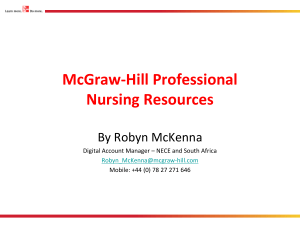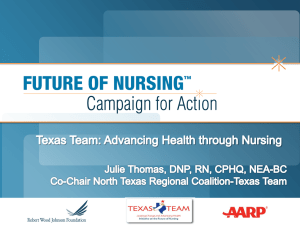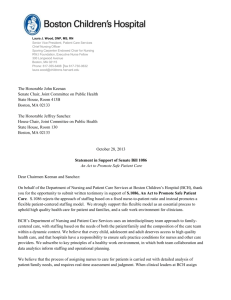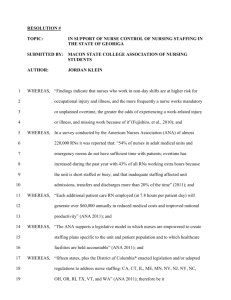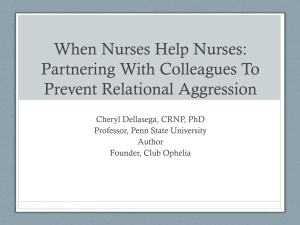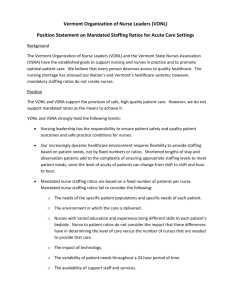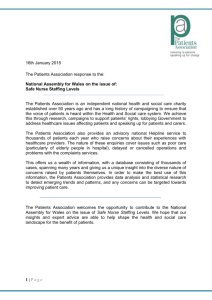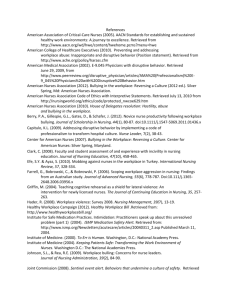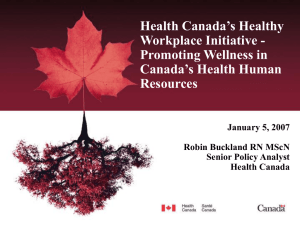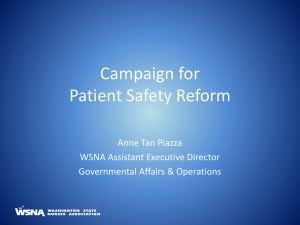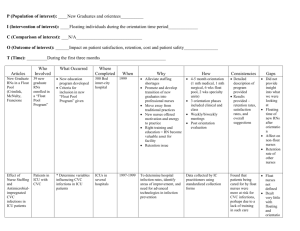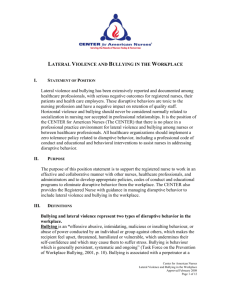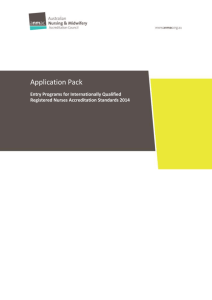10 Leadership Strategies for Creating Healthy Work Environments
advertisement
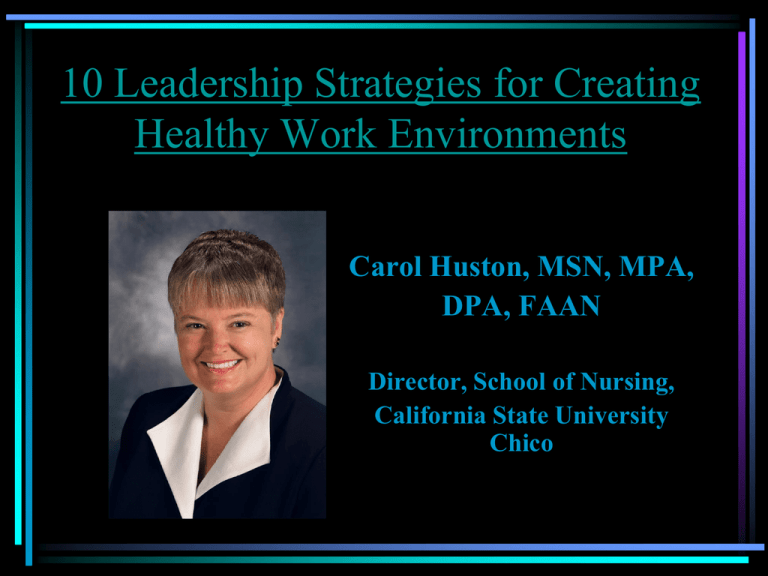
10 Leadership Strategies for Creating Healthy Work Environments Carol Huston, MSN, MPA, DPA, FAAN Director, School of Nursing, California State University Chico Thank you for inviting me to be here! Happy Nurse’s Week! Healthy Work Cultures Don’t Happen by Accident…. Changing unhealthy work cultures can be very difficult. An organizational culture is a system of symbols and interactions unique to each organization. It is the ways of thinking, behaving, and believing that members of a unit have in common. Subcultures are common in nursing. Ten Strategies Nurse Leaders Can Use to Create Healthy Work Environments #1. Create a Culture of Civility and Mutual Respect and Guard It Judiciously A recent survey of 2,100 Source: Johnson, C. (Nov. 2009). Bad blood: doctor-nurse behavior problems impact patient care. Physician Executive, 35 (6), 6-11. physicians and nurses by the American College of Physician Executives documented that unprofessional conduct in the workplace is increasing, with a shocking 98% of those surveyed reporting having witnessed behavior problems in the workplace in the past year. This is referred to in the report as “health care's dirty little secret.” Bullying in the Workplace Source: Roche, Diers, Duffield, and Catling-Pauli (2010) Patients Also Inflict Violence On Nurses Workplace Violence Statistics • In 2009, more than 50% of emergency center nurses experienced violence by patients on the job. • There were 2,050 assaults and violent acts reported by RNs requiring an average of four days away from work. • Of these acts, 1,830 were inflicted with injuries by patients or residents (Emergency Nurses Association). Source: American Nurses Association (2014). Bullying and workplace violence. Available at: http://www.nursingworld.org/Bullying-Workplace-Violence In 2008, the Joint Commission identified workplace bullying in a sentinel event alert saying that it threatened patient safety. Is incivility “just part of the job?” Workplace Bullying is NEVER OK. Courage to stand up for what is morally right. Obligation to adhere to the ANA Code of Ethics. Danger management by developing strategies to avoid risk aversion. Express your concerns effectively and take action. Source- Lachman, V. D. (Sept. 30, 2010). Strategies necessary for moral courage. OJIN, 15 (3), manuscript 3. Pitbulls On the Attack Bullying must always be confronted immediately. Potshot Artists Confronting the Potshot Artist…. The Clams Getting the Clam to Talk…. #2. Find Someone Outside the Organization to Vent To and Maintain Appropriate Boundaries Social media sites are not an appropriate place for venting. #3. Stretch and Empower Workers within Their Limits #4. Avoid Micro-Managing. (Get Out of the Way When You Can! Encourage Innovation Don’t be so quick to solve problems for others or they’ll never try to do it themselves. Your way is not always the “best way” or the “only way.” #5. Make Sure that Assigned Workload Is Reasonable So that Success is Even Possible Sometimes, the problem is that work load expectations are simply too great. New graduate nurses often need some time to learn the complexities of the nursing role. Our expectations of them need to match this reality. The need for graduates to 'hit the ground running' has manifested into a phenomenon coined 'Transition Shock' where the fear of making a mistake and feeling unsafe can be crippling to a new graduate’s confidence and self-image. Source- Harwood, M. (2011). Transition shock -- hitting the ground running. Nuritinga, (10), 8-18. That first step can be so hard…. Many staff nurses continue to report unreasonable workloads. A study comparing nurse staffing standards and staffing levels in nursing home care in six counties (the United States, Canada, England, Germany, Norway, and Sweden) found that both the standards and levels in most countries (except Norway and Sweden) were lower than the recommended levels by experts. Source: Harrington, C., Choiniere, J., Goldmann, M., Jacobsen, F., Lloyd, L., McGregor, M., & ... Szebehely, M. (2012). Nursing Home Staffing Standards and Staffing Levels in Six Countries. Journal Of Nursing Scholarship, 44(1), 88-98. Source: Gillen, S. (2012). Most nurses are struggling with inadequate staffing, survey shows. Nursing Standard, 26(34), 9. • Three in four respondents felt they did not have enough time to spend with patients to deliver dignified, safe and compassionate care. •Nurses on early and late shifts were the most likely to feel that the skill mix was inadequate. •Almost 2/3 were being forced to work overtime and only 1 in 13 were being paid for it. #6. Keep Lines of Communication Open and Deal with Problems As Soon As They Occur! Conflict in the organization is inevitable and must be dealt with before it becomes manifest. Sources of Conflict While diversity in the workplace is a strength, it can also be a source of conflict. Rule setting and constructive discipline are an essential part of a healthy work environment. Encourage employees to attempt to resolve their own interpersonal conflicts whenever possible! #7. Look to the Future While Focusing On the Present! Most 21st century healthcare organizations find themselves undergoing continual change directed at organizational restructuring, quality improvement, and employee retention. Stages of Organizational Development • Birth • Youth • Maturity • Aging Without change, organizations stagnate and die. The Story of an Aged Organization Contemporary nurse leaders then must be visionary in identifying where change is needed in the organization and be flexible in adapting to change they have directly initiated or by which they have been indirectly affected (Marquis and Huston, 2015). Malloch and Porter-O’Grady (2005) suggest that the future will increasingly call for a more fluid, flexible and mobile work environment, which requires an entirely innovative set of interactions and relationships as well as the leadership necessary to create them. Thought leadership refers to any situation whereby one individual convinces another to consider a new idea, product, or way of looking at things. Thought Leadership #8. Support and Recognize the Challenges Workers Experience with Constant Change in Healthcare • Knowledge information, acquisition and distribution will continue to multiply exponentially. In a profession where knowledge doubles every six years (Carroll, 2011), nurses can no longer be the keeper of knowledge; instead they must become the master of collecting and sharing that knowledge with others. The IOM (2010) suggests that the ways in which nurses were educated during the 20th century are no longer adequate for dealing with the realities of health care in the 21st century. Such profound change is not easy since all major change brings feelings of achievement and pride as well as loss and stress. Leaders must role-model positive and adaptive responses to change. Leaders embrace change and new ways of thinking. #9. Be Authentic! In 2005, the American Association of Critical-Care Nurses released a landmark publication identifying authentic leadership as one of the six standards necessary to establish and sustain healthy work environments in healthcare. • Becoming an authentic leader is a process that occurs over time and requires selfdiscovery, selfimprovement, reflection and renewal. Leadership traits can either work as a magnet or as a force that repels. There is little doubt that nurse leaders experience intrapersonal values conflicts between what they believe to be morally appropriate and a need to deliver results in a healthcare system, increasingly characterized by pay for performance and rewarded by cost containment. #10. Don’t Take Leadership for Granted Remember that followers are an important part of the leadership equation. Followers can stop following at anytime… Healthy work environments are all about mutual respect and groups working together to achieve shared goals. Changing negative work cultures is hard; it’s not impossible. Leaders do make a difference in creating healthy work environments. 10 Leadership Strategies for Creating Healthy Workplaces 1. 2. 3. 4. 5. Create a culture of civility and mutual respect and guard it judiciously. Find someone outside the organization to vent to and maintain appropriate boundaries. Stretch and empower workers within their limits. Avoid micro-managing and get out of the way when you can! Make sure that assigned workload is reasonable so that success is even possible. 10 Leadership Strategies for Creating Healthy Workplaces (cont.) 6. Keep lines of communication open and deal with problems as soon as they occur! 7. Look to the future while focusing on the present! 8. Support and recognize the challenges workers experience with constant change in healthcare. 9. Be authentic! 10. Remember that followers can stop following anytime, so don’t take leadership for granted. Questions?/ Comments?



